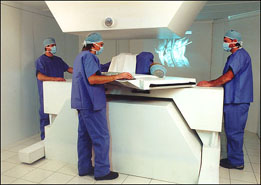Since the FONAR 360° ™ has ample room for an entire surgical team and its equipment, and allows for unrestricted 360-degreee access to the patient, the scanner can be fully outfitted for MRI-guided surgical and interventional procedures. Equipped for this future application, the scanner is called the OR-360°™ (MRI Operating Room).

Magnet Specs
Field Strength: 0.6 Tesla
Operating Frequency: 25.5 MHz
Patient Gap: 19 inches
Patient Access: 360 degrees
Treatment Room Specs
Standard 8-foot ceiling
Width: 14 Feet
Length: Unlimited
The OR-360°™ (MRI Operating Room) is a full-size room with a standard eight-foot ceiling. The two magnetic poles of the magnet are located in the center of the room. One of them protrudes from the ceiling and the other from the floor, leaving a large gap in which the patient lies. The main structure necessary to confine the MRI's strong magnetic field is located entirely outside of the room. Inside, only the patient is exposed to the main magnetic field. The entire attending medical team works without physical restrictions in a large and relatively magnetic-free environment. The patient can be placed on his back, stomach or side. A special moveable bed allows the patient to be positioned at any height and any angle according to the procedure at hand and the surgeon's preference.
Surgeons have always needed to see more than what meets the eye. Although endoscopic procedures (scopes) have been extremely useful in this regard, they only give surgeons a view of surfaces. But surgeons have the additional need to fully visualize the tissues they are about to cut into. Because of its exquisitely detailed images, MRI meets that need far better than any other modality, providing the surgeon with 3D vision of the interior of the body with sub-millimeter resolution, thereby enabling him to take the appropriate course of action with absolute confidence.
“The OR-360°™ ,says Dr. Raymond V. Damadian, president and chairman of FONAR, “is ideal for minimally invasive therapy. MR-guided probes with hollow bores can deliver a wide variety of therapeutic solutions and treatment agents directly to the pathological tissues. This means that the side effects on healthy tissue need no longer limit the dose of any therapeutic agents, enabling the final dose to be achieved within the tissue with certainty." He continued, "The surgeon can, with the MRI, simulate various paths to the target area. Once he determines the best one, he guides his catheter to the target for the delivery of treatment - RF, chemotherapy, microwave, drugs, etc.”
The Dual Purpose Scanner
MRI-guided surgical programs could be costly in their early stages due to
low utilization and the extra time physicians need to come up to speed.
The OR-360°™ presents the solution to this problem because it
is a dual-purpose scanner. When it is not being used for surgery, it can
be used, as is, for diagnostics. As a result, the revenues from routine
MRI diagnostic scanning can subsidize the surgical program for as long as
it takes to stand on its own financial feet.
Works in Progress